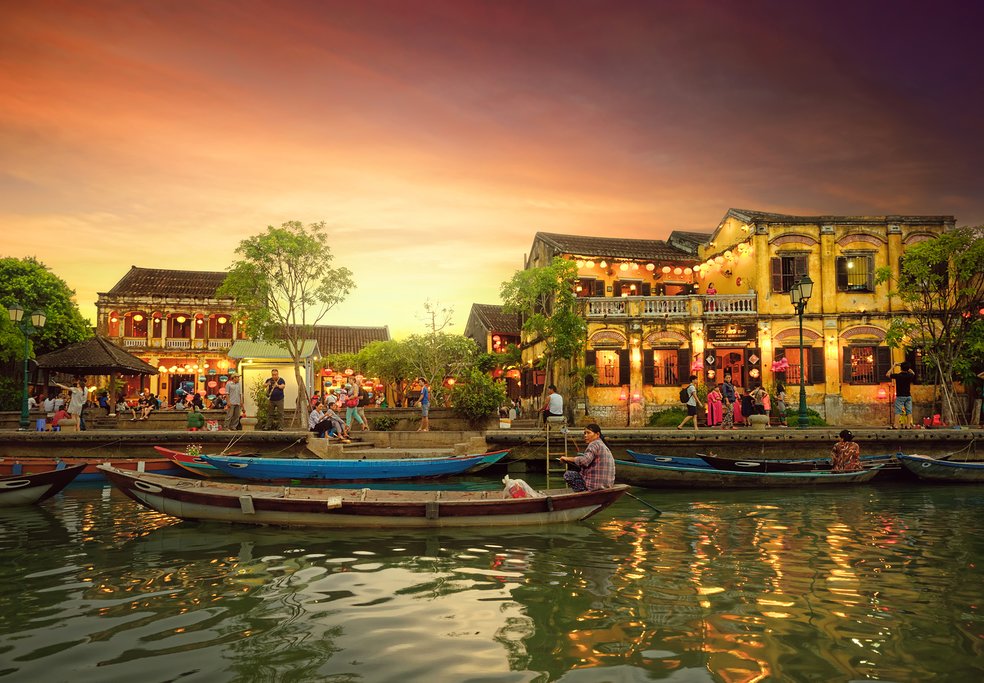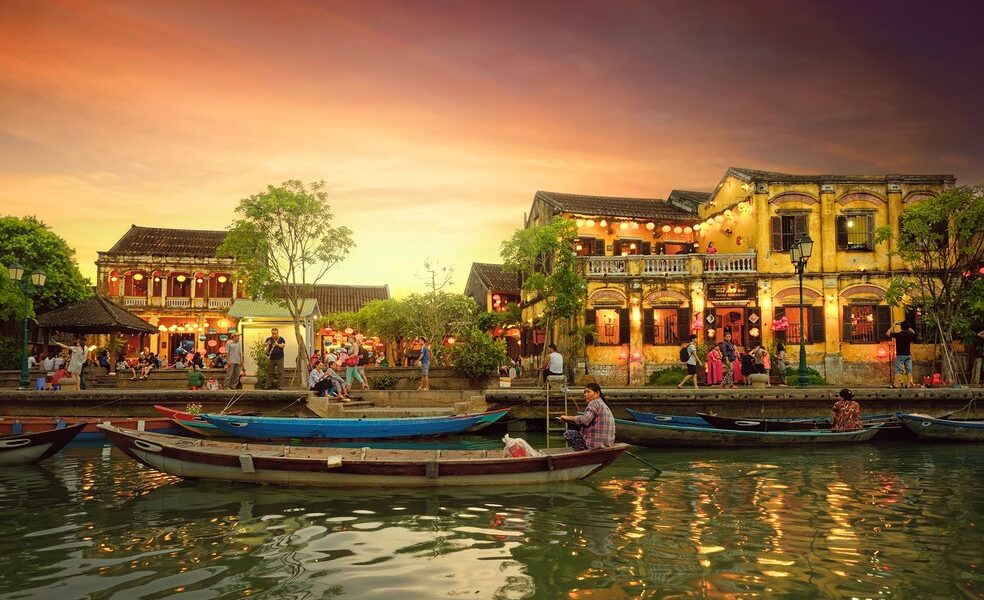
May is a transition month between spring and summer, with a good deal of rainfall and high temperatures in most of the country. Central and southern Vietnam enter into the steamy wet season, while Hanoi and the north remain relatively temperate and perfect for active adventures. With relatively few visitors this month, May offers plenty of reasons to visit, including plenty of days of sunshine.
Weather in Vietnam in May: A Comprehensive Guide
As May unfolds, the vibrant landscapes of Vietnam transition further into the embrace of the wet season. Across the country, the likelihood of rainfall steadily increases, marking a shift towards warmer temperatures and higher humidity. Preparing for this change in climate is essential for travelers. Packing appropriate rain gear is highly recommended to ensure comfort and protection from the elements. Insect repellent is also a must-have, safeguarding against the increased mosquito activity that accompanies the wetter conditions. Of course, don’t forget to pack your favorite summer clothing to enjoy the periods of sunshine.
Venturing into the northern hills reveals a varied weather landscape. In Ha Giang, the region begins to experience a noticeable increase in rainfall. However, heading further west towards the breathtaking Sapa region and the picturesque Mu Cang Chai, travelers can still enjoy predominantly dry weather conditions. These areas boast delightful temperatures, typically ranging from around 68 to 76 degrees Fahrenheit (20 to 24 degrees Celsius). The central coast of Vietnam benefits from the sheltering presence of the Truong Son mountain range. During the summer months, spanning from May through September, this region experiences relatively little rainfall. Meanwhile, the Central Highlands begin to feel the effects of the southwest monsoon, signaling a change in weather patterns. Consequently, the alluring beaches nestled between Hue and Nha Trang remain highly tempting destinations. With average temperatures hovering around a pleasant 86 degrees Fahrenheit (30 degrees Celsius), these coastal havens offer an inviting escape.
In contrast, the southern expanse of Vietnam, particularly the expansive Mekong Delta, presents a distinct weather profile. Here, hot and humid conditions prevail, accompanied by abundant rainfall. Fortunately, May brings a slight respite from the intense heat of April, offering a marginally cooler climate. As the summer season progresses, heavy rains can lead to disruptions, emphasizing the need for flexibility in travel plans and reliable rain gear. Despite the increased rainfall, travelers can still anticipate ample dry spells, allowing for exploration and enjoyment of the region’s attractions. It’s worth noting that much of the rainfall occurs in short, heavy downpours, typically during the afternoon and evening hours.
Crowds and Costs in Vietnam During May
The arrival of May signifies the tail end of the shoulder season, a period when most parts of Vietnam retain their appeal for travelers. For instance, visitors can still revel in the beauty of the country’s best beaches, basking in glorious sunshine without the overwhelming crowds that characterize earlier months of the year. In fact, only three months throughout the year witness fewer visitors than May. However, it’s important to acknowledge that regional variations exist, with the relatively dry Northern Vietnam, along with the beach resorts of Central Vietnam, maintaining their popularity among tourists.
During May, Vietnamese families generally prefer to stay closer to home, anticipating the school holidays that commence in mid-June. As a result, popular beaches such as Nha Trang and Quy Nhon won’t be as crowded with locals, offering a more tranquil experience. Similarly, top museums and renowned tourist sites in major cities are less likely to be packed with visitors. However, there is one notable exception: the April 30-May 2 holiday period. During this time, a significant number of Vietnamese people embark on sightseeing trips, often extending their travels to encompass a four-day break.
One noteworthy advantage of traveling to Vietnam in May is the potential for lower prices on tours and accommodations. As the peak season subsides, tour operators and hotels may offer discounts or be more open to negotiation. However, it’s essential to be aware of a potential downside: while the number of travelers decreases, the onset of the rainy season often leads to an increase in mosquito populations.
Where to Go in Vietnam in May
As the month of May commences, coinciding with the April 30-May 2 holiday, city dwellers often seek a brief escape from urban life, embarking on mini-vacations. Consequently, traffic congestion in major cities tends to ease, and there are fewer locals visiting museums and popular tourist attractions. This presents an opportune time to explore vibrant cities such as Hanoi, Hue, and Ho Chi Minh City. During this time of year, the average temperature in all three cities hovers around 84 degrees Fahrenheit (29 degrees Celsius). Travelers can focus their time on visiting key landmarks and enjoying the comfort of air-conditioned museums. However, it’s crucial to be prepared for potential rainfall.
Given that Central Vietnam experiences significantly less rainfall in May compared to other regions of the country, this month presents an ideal opportunity to spend time along its stunning beach-lined coast. The pristine white sandy beaches of Nha Trang, as well as those further north in Qui Nhon, offer relatively tranquil settings. The warm waters of the South China Sea are generally calm, inviting visitors to swim, relax, and soak up the sun. For those seeking a more secluded experience, Lang Co Bay beckons. This quiet, crescent-shaped beach remains mercifully undeveloped, providing a peaceful escape from the hustle and bustle. Furthermore, travelers can seamlessly combine beach time with cultural exploration, as the area boasts two UNESCO World Heritage Sites: Hue and Hoi An.
In Northern Vietnam, the terraced rice fields present a breathtaking spectacle during May. Lushly green and radiant yellow-gold with a newly planted rice crop, the fields shimmer and twinkle in the sunlight. This period, often referred to as the “falling water season,” witnesses cascades of water flowing from one terrace to another, creating a mesmerizing sight. Some of the most photogenic locations include Mu Cang Chai, Pu Long, and Trang An, situated at the edge of the Red River Delta. These picturesque landscapes offer unforgettable experiences for nature enthusiasts and photography enthusiasts alike.
What to Do in Vietnam in May
May provides an excellent opportunity to indulge in watersports activities in Nha Trang or other Central Vietnam beach resorts. Nha Trang, along with other well-established resorts, offers a diverse range of activities to suit various preferences. From sea-kayaking and water-skiing to kite-surfing, parasailing, and scuba diving, there’s something for everyone. In fact, Nha Trang is a particularly suitable location for obtaining an international scuba-diving certification (PADI). The shallow waters surrounding the islands of Nha Trang are not intimidating for beginners and also offer a rewarding snorkeling experience.
Consider embarking on a hike in Cuc Phuong National Park. Wildlife enthusiasts and travelers seeking active adventures will find Vietnam’s oldest national park (and still the country’s largest nature reserve) brimming with biodiversity. Spanning over 85 square miles (220 sq km), the park encompasses a lush tropical rainforest and a network of hilly, often slippery, trails that are sure to get your adrenaline pumping. Known for its stunning “butterfly season” in April and May, Cuc Phuong is also home to more than 300 bird species and nearly 90 species of mammals, including critically endangered endemic gibbons, langurs, and loris. While spotting these elusive creatures in the wild may require luck, visitors are guaranteed eye-to-eye encounters at the park’s Endangered Primate Rescue Center. Before venturing into the park, it’s advisable to wear sturdy hiking shoes, apply mosquito repellent generously, and bring ample bottled water to stay hydrated.
B-2731

